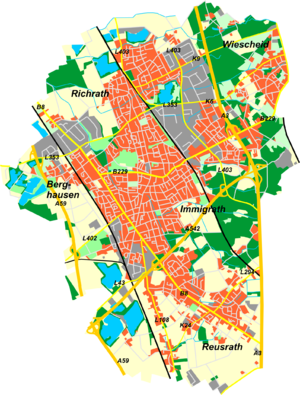Moth Flachenhof
| Moth Flachenhof | ||
|---|---|---|
|
Motte Flachenhof am Blockbach in Langenfeld-Immigrath |
||
| Creation time : | middle Ages | |
| Castle type : | Niederungsburg, moth | |
| Conservation status: | Castle hill present | |
| Place: | Langenfeld - Immigrath | |
| Geographical location | 51 ° 6 '22.6 " N , 6 ° 58' 18.6" E | |
|
|
||
The Motte Flachenhof is a castle ruin registered as a ground monument in Langenfeld - Immigrath and goes back to a medieval hilltop castle (Motte) .
location
The moth near the Flachenhof farm is located southwest of the intersection of the Troisdorf-Mülheim-Morsbroich-Opladen-Immigrath-Richrath-Speldorf railway and the A 542 .
Descriptions and reports
The oldest mention of 1894 comes from The Art Monuments of the Rhine Province by the author Paul Clemen . Rolf Müller quotes him as follows: “North of Immigrath, 20 paces from the railway , a hill fort in the bush , called 'am Bone Mountain' or 'old castle', an approximately rectangular hill 80 to 100 paces on a side, with a wall and swamp Surrounding ditch . The owner only removed the stones from the wall 15 years ago ”, around 1879. Addition: Of course, it would have to be correctly“ south of Immigrath ”or“ north of Reusrath ”.
In 1949, Rafael von Uslar from the Rheinisches Landesmuseum Bonn visited the facility between Knieberg and Hardt in the corridor Am Burgberg . He summarized his impressions as follows: “Close to the west of the Immigrath-Opladen railway, about 950 m southeast of the trigonometric point P.53.09, on the southern edge of a scrub-covered swampy strip of wasteland on the northern edge of a dirt road, there is only half of sandy gravel Heaped round hill about 20 m in diameter and 2.5 m high. Any culture inclusions and the like could not be observed in the profile . The hill is surrounded on the unaffected side of a still water-filled ditch in the leads another trench that probably does not overseeable in the undergrowth former outer ward should include. "
And in 1955, Heinz Müller reports from the castle that "until a few years ago it still had a well-preserved moat and a square, heaped up sand hill (about 10 × 10 m) in the middle of the swamp ". He also attributed the saga of the sunken castle to the castle ruins . Rolf Müller also considered this moth to be the place to which the legend was bound (for the legends themselves, see: Hapelrath ). Regardless of such considerations, the field name Am Burggraben and the name Burgstrasse in Immigrath have been preserved to this day. Shards found on the castle ruins around 1985 also testify to the settlement of this place until the 12th century.
The Flachenhof motte is shown today, as described in 1949 by the employee of the Office for Monument Preservation , namely as a half-preserved hill about 20 meters in diameter, which is still surrounded by a moat on the side facing the railway . Another ditch flows into this on the side of the motorway (which did not exist at the time), which apparently must have surrounded the outer bailey. However, current pictures of the castle from the winter months show that this outer bailey has now been completely leveled. The trenches receive an inflow from the Blockbach, even if the system can fall completely dry in very dry summers.
It should also be emphasized from Clemens' description that this castle was called the Alte Burg . And in fact, the Dückeburg, a former brick moated castle of more recent date, only about one kilometer away . Therefore, the Motte Flachenhof can be considered the predecessor of the Dückeburg, comparable to the Motte Schwanenmühle in relation to the Graven House in Wiescheid . Because it is characteristic that not far from the moths, as a rule, younger moated castles and solid courtyards were built. The fact that remains of such a tower hill castle were also discovered near the third known knight's seat in Langenfeld, the Langfort estate , should be added as an aside.
To the sunken castle
As already mentioned above, both Heinz Müller and, following him, Rolf Müller ascribed the legend of the sunken castle to the Motte Flachenhof . However, to associate the legend of a sunken castle with such a well-preserved complex does not seem convincing, as the removal of the ramparts around 1879 must have required some effort. The hint that followed that a facility only a few 100 meters south with another sand hill would be better suited than the location of the legend, but is only mentioned here. In addition, there is a report about a carved female saint figure found in the area of the outer bailey in the 1950s. However, since the “treasure diggers” themselves have lost this in the meantime, all further considerations are speculation.
Individual evidence
- ↑ a b c d e f Rolf Müller: City history Langenfeld Rhineland . Langenfeld City Archives, 1992.
- ↑ a b Heinz Müller: Place and field names of the city of Langenfeld tell from days gone by . In: Local calendar Rhein-Wupper-Kreis 1955 .
- ↑ Claus-Peter Peters, " Langenfeld im Wandel der Zeiten ", self-published 2013, pp. 15, 16
- ^ Friedhelm Görgens: Langenfeld . Droste, Düsseldorf 1984, pp. 17, 18
- ↑ Claus-Peter Peters: The legend (s) of the sunken castle . BoD 2005, pp. 27, 28
- ↑ ritter-pitter.de, Marienfigur / Motte am Blockbach ( Memento from September 14, 2014 in the Internet Archive ), accessed September 14, 2014.
Web links
- Photos of the moth, [1]

